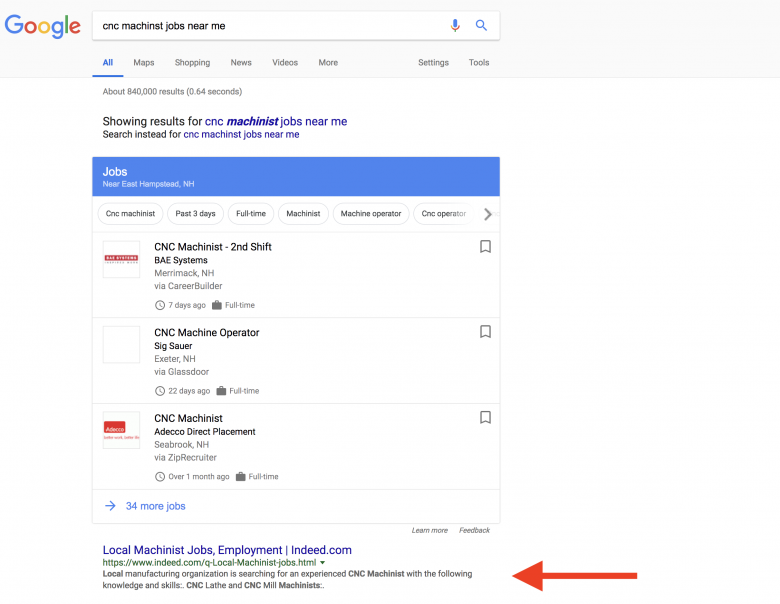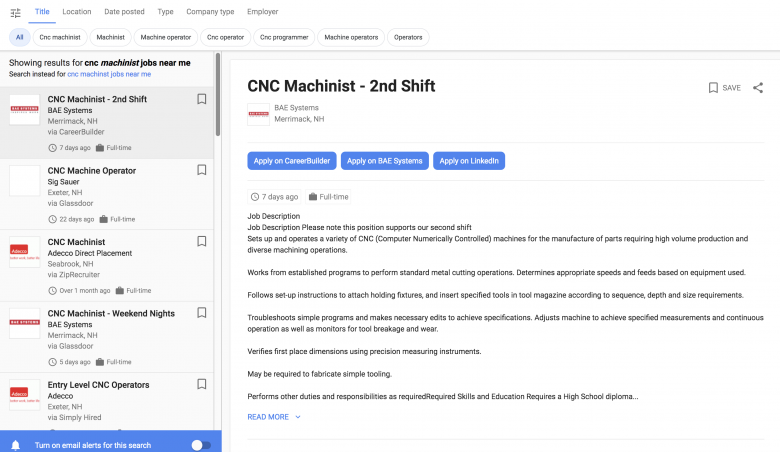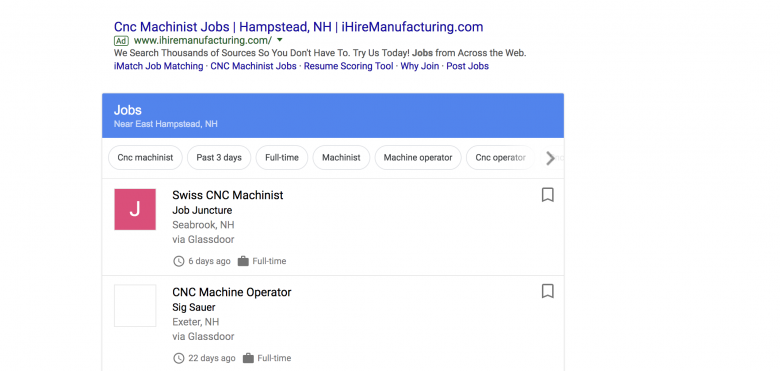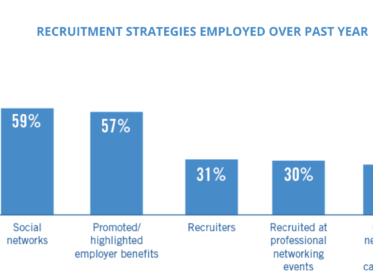The job recruitment market is a $200 billion industry and includes heavy weights Google, Indeed.com, Monster and a whole host of small to mid-size recruiting firms and temp / staffing agencies.
In addition to posting your open manufacturing jobs to job sites, we list five other strategies you can use to effectively market your open positions.
Strategy #1: Pay to get listed inside the Google Job Search Box
If you’re like many small businesses, you may use Indeed.com to post job listings. If you do, you should note that Indeed listings appear beneath Google’s job search box versus in the search box itself (Figure 1).

Currently, Google has documentation that allows you (or your developer) to add “structured data” to your website code. This structured data is necessary for your job listings to be added to the Google job search box.
We’ve tested this with a client and have found that the listings didn’t appear or were buried. We believe it’s because the client had only a few listings, whereas larger employers would have dozens or even hundreds of listings — which got picked up by Google.
Therefore, if you want your listings to appear within Google’s search box, you may want to consider paying to be listed on one of the third-party sites Google partners with. Costs vary by site. We priced out getting job listings in Snagajob, for example. One job listing is $99 a month. Sixteen listings priced out at $1040 a month – and that included the volume discount.
Job listings from very small companies may appear in the search box at some point, so this is something you’ll want to watch.
For additional info, see our piece on the Google for Jobs platform.
PROS: Gets your listings in front of job searchers using Google’s tools.
CONS: Getting listed may extend your budget; you’re competing with dozens of other companies; there’s no guarantee where your listing will show position-wise.
Strategy #2: Create a careers section on your website
Advertising open positions on a third-party site is a great tactic for getting found by searchers using Google. However, by adding a Careers section to your own website, you can add a link in your profile to it (the way BAE did in Figure 2).

With a Careers section, you can better sell your company to prospective job searchers and show them, through photos and messaging, why they should consider coming to work for you. (See how Summit Metal Fabs did it; page 6 in Issue 11 of Manufacturing Marketing Magazine.)
The Careers section should include, at minimum:
- Listings of all open jobs, locations, hourly rates / salary, etc.
- How to apply and a mobile-friendly online job application form
- Benefits, hours, etc.
- Company information: Culture, number of employees, the company story, etc.
You can also include written or video testimonials from current employees, photos of company events or people at work — anything that will show your company is innovative, modern, and diverse (age, ethnicity, gender, etc.).
PROS: Let’s you tell your story and communicate
CONS: Will require time and maybe outside help to create the new content, gather photos, etc.
Strategy #3: Place Help Wanted signs street side
One manufacturing company in the local area has a simple “Now Hiring – Apply Inside” sign at the foot of their driveway, which faces a high-traffic area. Signage like this is good as everyone who drives by sees it — and if someone is looking for a job, or knows of someone looking, it’s easy to capture their interest.

PROS: Low to no cost — depending on your skills.
CONS: Inviting people into your facility, without telling them which jobs are available, wastes their time and yours.
Strategy #4: Run a Google Ad Campaign
The benefit of using Google Ads is that you can set your bids high enough so that your ads appear above the Google job search box (Figure 4) — and thus searchers may click your ad before making their way into the box.

PROS: Buy your way to the top of the search page.
CONS: Running a recruitment campaign on Google Ads can be complex and costly if you don’t know what you’re doing. We recommend hiring a seasoned Google Ads pro to help you.
Strategy #5: Post job openings to social media
Whether you’re on Twitter or LinkedIn, you can post open job positions in your feed at no cost. You can also use the for-fee job listing services of LinkedIn and Facebook.
PROS: Easy to micro target ads to very select audiences using demographic targeting tools; both LinkedIn and Facebook are Google for Jobs partners, so your listings will show in the jobs search box.
CONS: If you don’t know your way around the platforms’ advertising tools, you could end up spending a lot of money while in learning curve mode — or not see any results.




